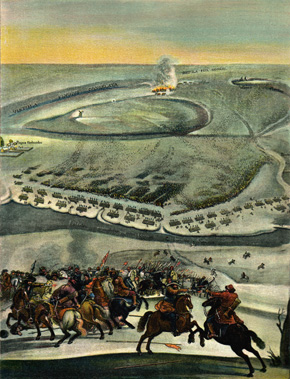

This article includes a list of general references, but it lacks sufficient corresponding inline citations. Please help to improve this article by introducing more precise citations. (September 2014) (Learn how and when to remove this message)
|
| Battle of Gołąb | |||||||
|---|---|---|---|---|---|---|---|
| Part of the Northern War of 1655–1660 and The Deluge | |||||||
 The Battle of Golab by Johann Philip Lemke | |||||||
| |||||||
| Belligerents | |||||||
|
|
| ||||||
| Commanders and leaders | |||||||
|
|
| ||||||
| Strength | |||||||
| 3,000–4,000 | 1,800–1,900 | ||||||
| Casualties and losses | |||||||
| 100-150 | 147[1] | ||||||
The Battle of Gołąb was fought on either 18 or 19 February 1656, between forces of the Polish–Lithuanian Commonwealth commanded by Stefan Czarniecki on one side, and on the other Swedish Empire's army commanded by Charles X Gustav. This battle was essentially a meeting engagement with Swedish troops arriving on the battlefield at different times. It is uncertain how many actually participated, and its actual date is disputed. Some sources, such as Polish-language Military Encyclopedia, claim it took place on 18 February, while historian Leszek Podhorecki wrote that it was on 19 February. The outcome was a Swedish victory.
In mid-February 1656, Swedish army under King Charles X Gustav camped near a village of Golab, located in northern Lesser Poland, near the confluence of the Wieprz and Vistula rivers. The Swedes awaited Polish units of Stefan Czarniecki. The Poles were divided into two groups; one commanded by Czarniecki himself, another headed by Colonel Sebastian Machowski. Swedish units had a number of Polish soldiers, who had deserted to their side. Among the Poles that served the Swedish King in this battle, was Jan Sobieski.
According to Polish historian Leszek Podhorecki, King Charles Gustav, after finding out about anti-Swedish insurrection in southern Lesser Poland, decided to move his army there. The Swedes crossed the Pilica river on 12 February, forcing Czarniecki to withdraw behind the Vistula, and camp near Golab.
Swedish army crossed the frozen Vistula near Kazimierz Dolny, surprising a Polish regiment stationed there. The Swedes then moved along right bank of the river, reaching Golab, where they surprised the scattered Polish forces. Swedish front guard, under General Horn and Count Valdemar Christian of Schleswig-Holstein opened fire, moving forwards. This caused retreat of Polish forces, which was stopped by Czarniecki, who ordered a counter-attack.
At the same time, additional Swedish units entered the fray, gaining numerical superiority over the Poles. Swedish regiments, commanded personally by the King, backed for a while, but soon Polish attacked was halted under Swedish fire. To prevent his forces from complete destruction, Czarniecki ordered them to retreat. A number of Polish soldiers drowned while crossing the Wieprz, when the ice broke. Total Polish loses, however, were estimated at less than 150, mainly due to Czarniecki’s order to give up the battle and flee.
Charles Gustav was confident that the battle ended in complete destruction of Czarniecki’s army. This was untrue, as the Poles used a manoeuver, which they had observed while fighting Crimean Tatars. Their forces scattered across the area, to concentrate again after a few days. The Battle of Golab was described by Henryk Sienkiewicz, in his novel Deluge.
Swedish Regiments:
Total: 6,005 The individual unit strength figures are based on unit strength figures from five months or more previous to the battle.
Polish Troops in Swedish Service Kosack (Pancerni):
Total: 906
Tartars (Light Cavalry):
Total: 873
The Army was divided in two regiments:
Hussars -
Kosack (Pancerni) -
Total: 2,642
Units marked with * did not take part in the battle. They were escorting recruits.
51°29′13″N 21°52′31″E / 51.486944°N 21.875278°E / 51.486944; 21.875278